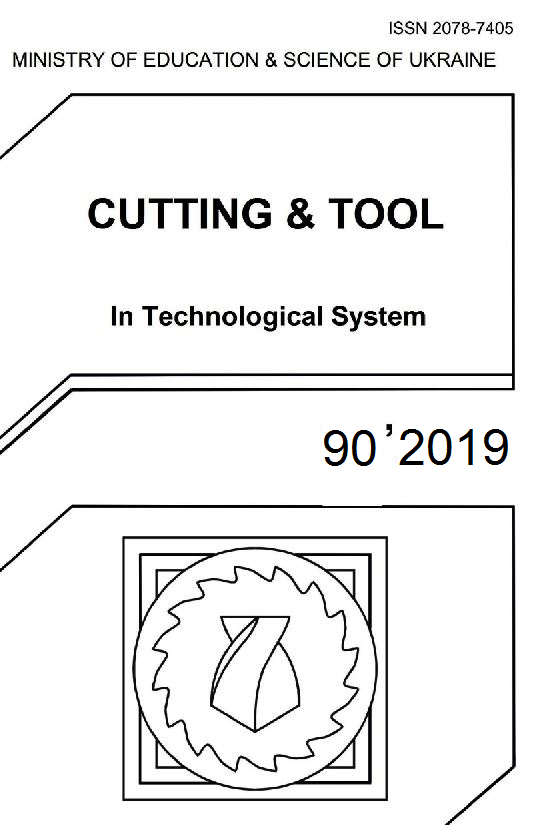INVESTIGATION OF THE EFFECT OF DEPTH OF CUT AND CUTTING SPEED ON CUTTING FORCES DURING FACE MILLING OF STEEL WITH A RECTANGULAR CUTTING INSERT
DOI:
https://doi.org/10.20998/2078-7405.2019.90.01Keywords:
face milling, cutting forces, depth of cut, cutting speed, rectangular insertsAbstract
In metal machining processes, the achievement of a sufficiently high material removal rate is desirable. Material removal rate can be increased to the desired value by an increase of feed rate value and also by increase of cutting speed or depth of cut values. However, as it is also required that surface quality and deformation should be within the acceptable limits, it is necessary to control them by selecting the appropriate process parameters values. In this study, face milling experiments are conducted in order to investigate the effect of using different values of depth of cut and cutting speed on the cutting forces and specific cutting forces. A comparison between the experimental results from cases with constant feed rate and two different depths of cut at four different cutting speed values, ranging from 100 to 400 m/min is conducted. After the subsequent analysis of the results, conclusions on the effect of depth of cut and cutting speed on cutting forces and specific cutting forces are drawn.References
Kundrák, J., Markopoulos, A.P., Makkai, T., Deszpoth, I., Nagy, A.: Analysis of the effect of feed on chip size ratio and cutting forces in face milling for various cutting speeds, Manufacturing Technology 18(3), pp. 431-438. (2018).
Kundrák, J., Makkai, T., Markopoulos,
A.P.: Investigating the impact of feed and cutting speed on cutting forces for the increase of surface removal rate in face milling, Cutting & Tools in Technological Systems: NTU ‘KhPI’ 87, pp.126-132. (2017).
Kundrák, J., Makkai, T., Deszpoth, I., Nagy, A.: Investigation of cutting force in face milling, Cutting & Tools in Technological Systems: NTU ‘KhPI’ 87, pp.118-125. (2017).
Subramanian, M., Sakthivel, M., Sooryprakash, K., Sudharakan, R.: Optimization of cutting parameters for cutting force in shoulder milling of Al7075-T6 using response surface methodology and genetic algorithm, Procedia Engineering 64, pp. 690-700. (2013).
Čekić, A., Begić-Hajdarević, Đ., Kulenović, M.: Effect of the cutting parameters on cutting forces in high speed face milling, Tehnički Vjesnik 20(5), pp.775-780. (2013).
Ghoreishi, R., Roohi, A.H., Ghadikolaei, A.D.: Analysis of the influence of cutting parameters on surface roughness and cutting forces in high speed face milling of Al/SiC MMC, Materials Research Express 5(8), 086521. (2018).
Kaya, E., Akyüz, B.: Effects of cutting parameters on machinability characteristics of Ni-based superalloys: a review, Open Engineering 7, pp. 330-342. (2017).
Ghani, J.A., Choudhury, I.A., Hasan, H.H.: Application of Taguchi method in the optimization of end milling parameters, Journal of Materials Processing Technology 145, pp. 84-92. (2004).
Aykut, Ş., Kentli, A., Gülmez, S., Yazıcıoğlu, O.: Robust multiobjective optimization of cutting parameters in face milling, Acta Polytechnica Hungarica 9(4), pp. 85-100. (2012).
Xu, C., Dou, J., Yuzhen, C., Huaiyuan, L., Zhicheng, S., Jing, X.: The relationships between cutting parameters, tool wear, cutting force and vibration, Advances in Mechanical Engineering 10(1), pp. 1-14. (2018).
Pathak, B.N., Sahoo, K.L., Mishra, M.: Effect of machining parameters on Cutting forces and surface roughness in Al-(1-2)Fe-1V-1Si Alloys, Materials and Manufacturing Processes 28(4), pp. 463-469. (2013).
Subramanian, A.V.M., Nachimuthu, M.D.G, Cinnasamy, V.: Assessment of cutting force and surface roughness in LM6/SiCp using response surface methodology, Journal of Applied Research and Technology 15, pp. 283-296. (2017).
Downloads
Published
Issue
Section
License
Copyright Notice
Authors who publish with this Collection agree to the following terms:
1. Authors retain copyright and grant the Collection right of first publication with the work simultaneously licensed under a Creative Commons Attribution License that allows others to share the work with an acknowledgement of the work's authorship and initial publication in this Collection.
2. Authors are able to enter into separate, additional contractual arrangements for the non-exclusive distribution of the Collection's published version of the work (e.g., post it to an institutional repository or publish it in a book), with an acknowledgement of its initial publication in this Collection.
3. Authors are permitted and encouraged to post their work online (e.g., in institutional repositories or on their website) prior to and during the submission process, as it can lead to productive exchanges, as well as earlier and greater citation of published work.

